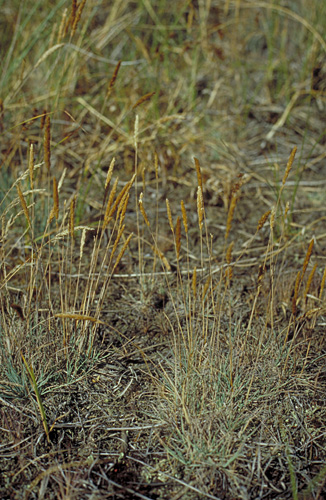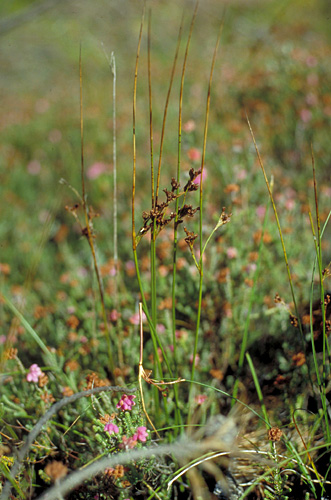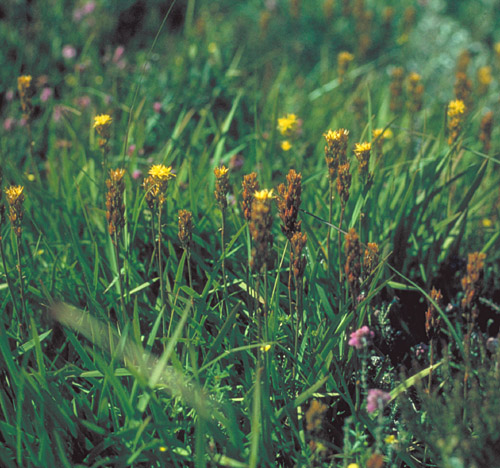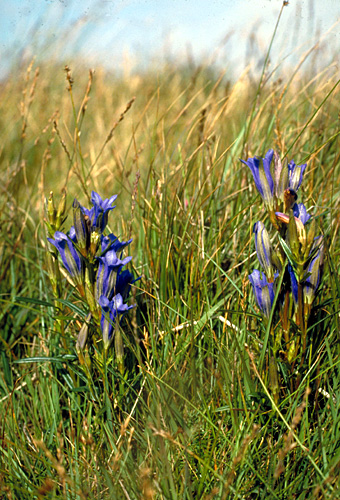
Most of the western coasts of
Jutland are covered with
sand dunes blown
op from the shore by the dominating and often strong western winds
coming
in from the North Sea. The mobile dunes near the coast have a sparse
vegetation
and contains chalk from mussels and snails, and they appear white in
colour.
Further away from the coast they become fixed by the spreading
vegetation.
By time the chalk leaches and the sand turns grey. These leached fixed
dunes gradually develop to coastal heath.
Not only the sand is grey in the leached fixed dunes. In places the vegetationen is also greyish. It is different species of lichens and Grey Hair-grass (Corynephorus canescens), which gives the colour.
Koeleria glauca (photo) is in Denmark almost entirely confined to sand dunes along the west and north coast of Jutland. On Hulsig Hede in Vendsyssel this species is common in the zone between the fixed white dunes and the leached fixed dunes.
As the leached fixed dunes are poor in chalk and other nutrients, many species of heath plants can be found here. Common are Heather (Calluna vulgaris), Crowberry (Empetrum nigrum), Creeping Willow (Salix repens var. argentea), Hawkweed (Hieracium umbellatum), Heath Dog-violet (Viola canina), Sand Sedge (Carex arenaria) and Sheep's-bit (Jasione montana).
Depressions in the leached fixed dunes and coastal heaths are often wet due to standing ground water. The sand is acidic and poor in nutrition and the wet depressions are often covered with bog-like vegetation (oligotrophic fen). Common species in the fens are Cross-leaved Heath (Erica tetralix), Tormentil (Potentilla erecta), Cranberry (Vaccinium oxycoccus), Marsh Pennywort (Hydrocotyle vulgaris), Marsh Cinquefoil (Potentilla palustris), the grasses Purple Moor-grass (Molinia caerulea) and Velvet Bent (Agrostis canina) and members of the Sedge family as Common Cottongrass (Eriophorum angustifolim) and Common Sedge (Carex nigra). On tufts of Sphagnum it is possible to find the carnivorous plant Round-leaved Sundew (Drosera rotundifolium)
Not only the sand is grey in the leached fixed dunes. In places the vegetationen is also greyish. It is different species of lichens and Grey Hair-grass (Corynephorus canescens), which gives the colour.
Koeleria glauca (photo) is in Denmark almost entirely confined to sand dunes along the west and north coast of Jutland. On Hulsig Hede in Vendsyssel this species is common in the zone between the fixed white dunes and the leached fixed dunes.
As the leached fixed dunes are poor in chalk and other nutrients, many species of heath plants can be found here. Common are Heather (Calluna vulgaris), Crowberry (Empetrum nigrum), Creeping Willow (Salix repens var. argentea), Hawkweed (Hieracium umbellatum), Heath Dog-violet (Viola canina), Sand Sedge (Carex arenaria) and Sheep's-bit (Jasione montana).
Depressions in the leached fixed dunes and coastal heaths are often wet due to standing ground water. The sand is acidic and poor in nutrition and the wet depressions are often covered with bog-like vegetation (oligotrophic fen). Common species in the fens are Cross-leaved Heath (Erica tetralix), Tormentil (Potentilla erecta), Cranberry (Vaccinium oxycoccus), Marsh Pennywort (Hydrocotyle vulgaris), Marsh Cinquefoil (Potentilla palustris), the grasses Purple Moor-grass (Molinia caerulea) and Velvet Bent (Agrostis canina) and members of the Sedge family as Common Cottongrass (Eriophorum angustifolim) and Common Sedge (Carex nigra). On tufts of Sphagnum it is possible to find the carnivorous plant Round-leaved Sundew (Drosera rotundifolium)


